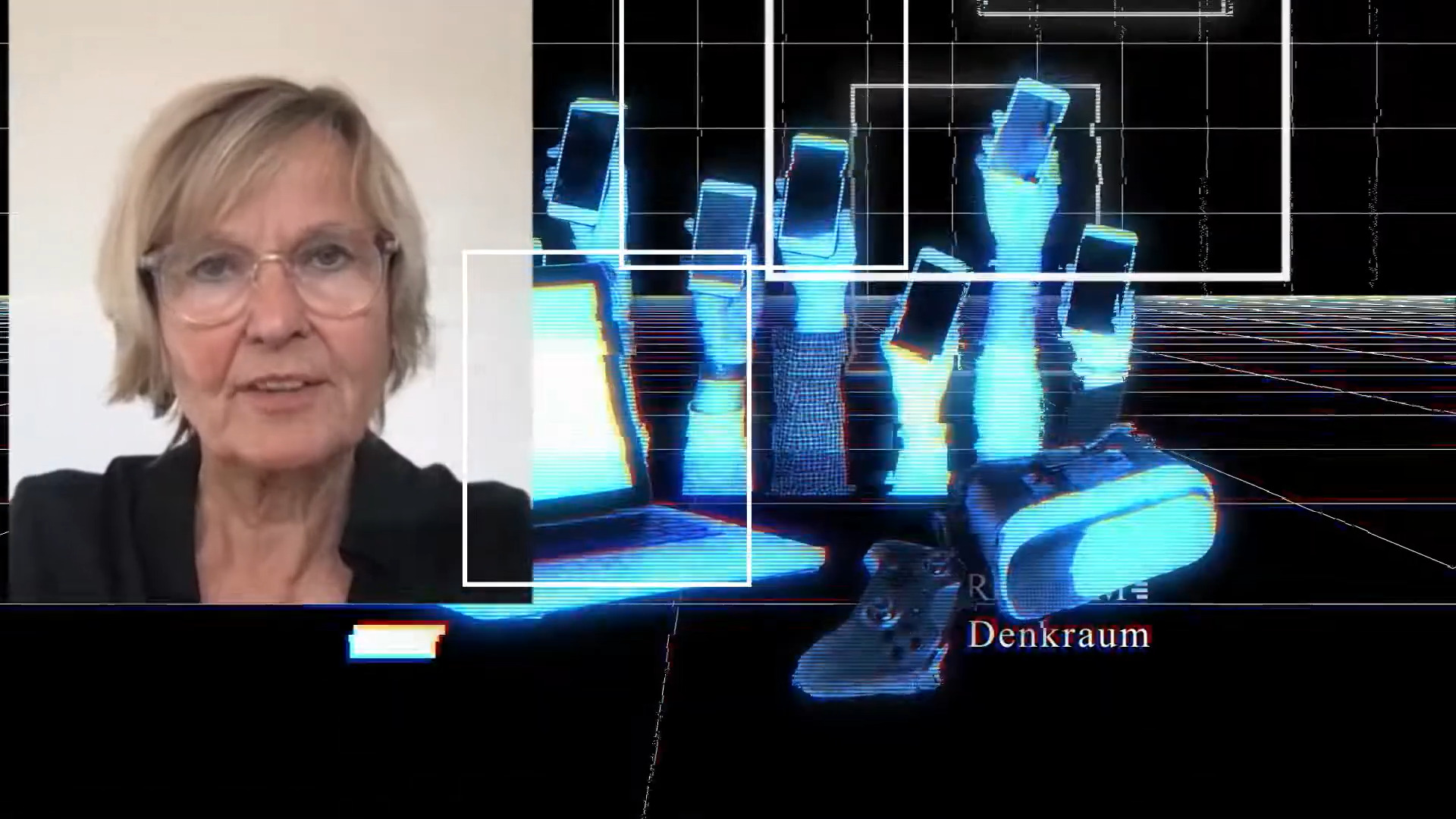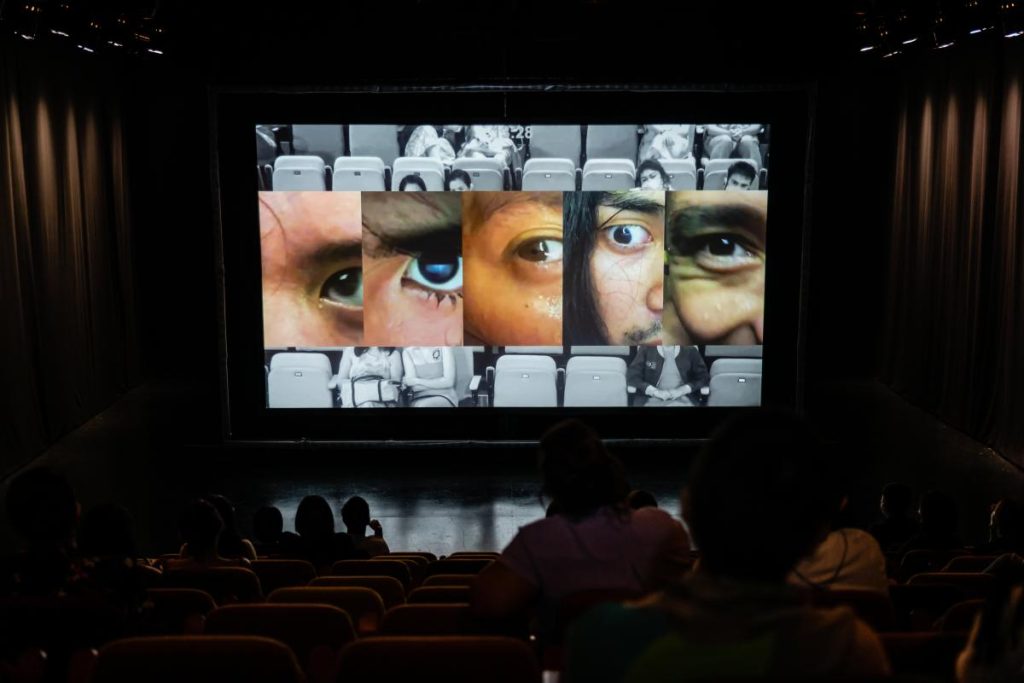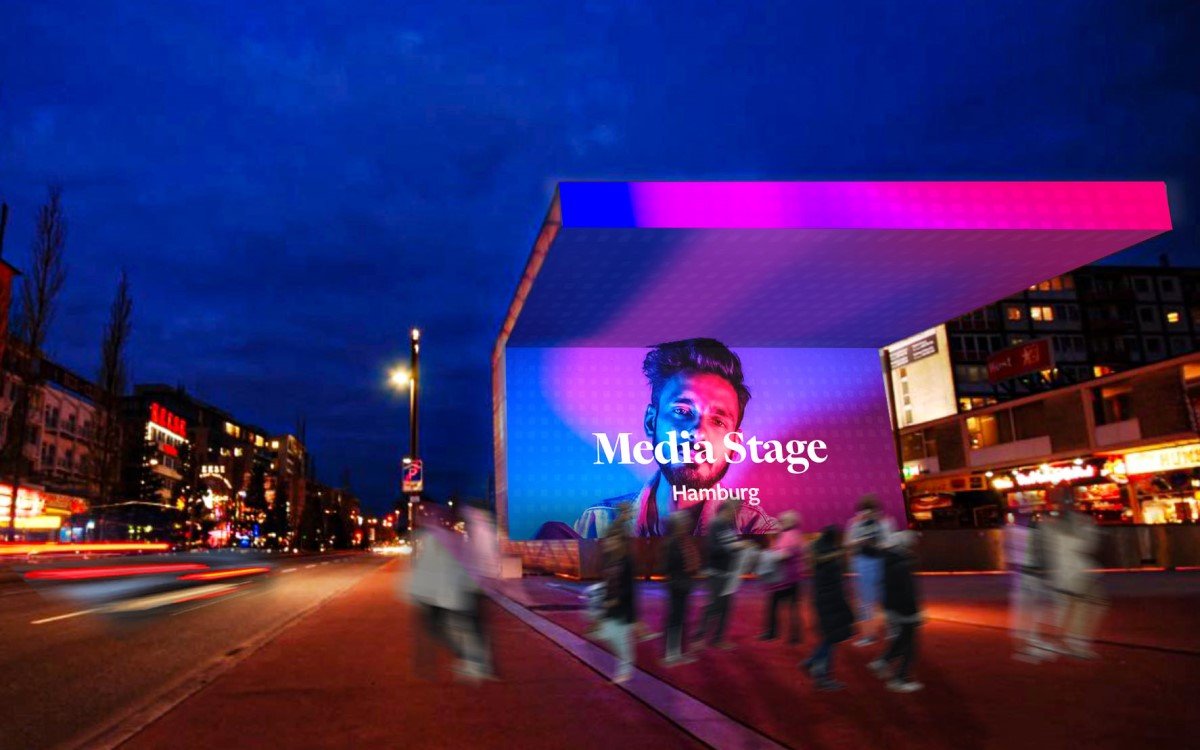Digital Stages. Sensual co-presence in hybrid performances
gabriele klein
Cultural globalisation since the 1990s would not have been possible without the transition from analogue to digital communication. Digital, global, real-time communication, made possible by smartphones and social media, has created what cultural scientist Felix Stalder calls a ‘culture of digitality’.[1] In contrast to the more technical concept of digitalisation, digitality is a concept from cultural studies and the social sciences that grasps the interconnections of the analogue and the digital and identifies them as the main characteristics of culture. Digitality thus refers to a cultural phenomenon of the globalised contemporary society, which both ties in with existing habits of media communication — writing letters or telephoning — as well as decisively changing everyday lives in terms of how people communicate with each other and inform themselves. While digitalisation has made global communication possible for almost everyone who has access to digital devices, it is the digitality of culture that has changed the quality of communication and with it the modes of perception and experience worldwide. Everyday activities — whether eating together, sex, sport, care, work, art appreciation — are increasingly taking place in an ‘onlife’, as the Italian philosopher Floridi calls the interweaving of the digital and the analogue.[2] And this ‘onlife’ also characterises the performing arts.
Debates in cultural studies and the social sciences tend to take digitalisation to imply a loss of proximity, trust, affection, devotion, etc. in a vein of cultural criticism, or as a euphoric expansion of global communication.
I advocate neither cultural pessimism nor naïve euphoria. Rather, I ask how ‘onlife’ has changed the perception of artistic stage performances.

Fig. 1: Gabriele Klein in a still from ‘Ferner Körper. Berührung im digitalen Alltag’. Germany, 2022. Video. https://youtu.be/4kh3e6Vi6-s?feature=shared.
The stage is the last bastion of the analogue. Co-presence, aura, event, unrepeatability are the central features theatre scholars use to distinguish theatre from other media. But what happens when either the audience is absent from the location of the performance, or the audience is sitting in the theatre but the performers are not on stage? Is it no longer possible to affect the audience? Is it no longer possible to be touched by a piece?
I argue that touch — even in stage performances — is independent of physical presence. This thesis diverges from some positions in theatre studies, but it is not new to media and film studies, having been often proposed. However, even media studies usually fail to answer the following question: what determines whether an audience is touched? I claim that this being touched happens through the possibility and ability of sensual co-presence. By sensual co-presence I mean an apprehension of sensing, feeling and experiencing, which certain media can induce.[3]
Stage performances in hybrid spaces
Stage art has always seen itself as a bulwark against digitality and virtuality. The theatre, unlike the cinema, is seen as a place of co-presence between performers and audience, and the performance as a unique event shared only among those present.
But this perspective had already begun to falter by the turn of the 20th century. Since then, the theatre has faced strong competition in the form of cinemas. In 1895, the first film ever was shown in the Wintergarten, a famous variety theatre in Berlin-Mitte, and the history of cinema — and with it the history of a global medium — began.
To this day, there remains controversy — intensified by pandemic-induced closures – about the social legitimacy of subsidising theatres as sites of bourgeois representational culture (still or again) in contrast to commercially operated cinemas and what distinguishes theatrical and cinematic experiences. Theatre scholars cite co-presence as one such distinction.[4] In the 2000s, German theatre scholar Erika Fischer-Lichte defended the particular mediality of theatre by emphasising the co-presence of actors and audience members, i.e. their physical presence in one place, as a special characteristic of theatre and deducing from this the uniqueness of the theatrical experience. She understands co-presence as an interaction where actors and spectators assemble in person in a specific place for a certain duration.[5] Fischer-Lichte understands co-presence as a basic condition for the possibility of affective contact with the audience. Since in cinema, television and the internet, audience and actors are not together in one place but scattered globally, according to Fischer-Lichte, they experience no co-presence and no affective connection can take place.
Her concept of co-presence has been repeatedly criticised. As media scholars have shown, being touched is just as possible via analogue and digital media as it is in the theatre. One can root for the main character in a TV movie, empathise with the worries and hardships of the protagonist in a novel, cry while listening to recorded music, get goose bumps or be reassured when a film ends happily. There is no need for both the actors and the audience to be present in the same place; physical co-presence is not a prerequisite for being touched.
Being touched takes place in the tension between sensing, feeling and experiencing, and it changes according to the mediality of the medium and its sensual perception. One is immersed in a novel or film through empathetic understanding and imagination, while at a dance performance one can feel the movements of the dancers and possibly even smell their sweat in the front rows. The choreographer Pina Bausch, for example, loved stages with water, earth and grass because these natural materials also exude unique scents.[6] So can you understand a digital presentation as a co-presentational theatre performance?
The Filipino choreographer and visual artist Eisa Jocson has addressed this question. Jocson took the pandemic as an opportunity to develop the piece ‘Manila Zoo’, which is the name of the actual zoo and botanical garden in Manila. Six performers are connected to the Mousonturm theatre in Frankfurt, Germany by a video chat. The audience is in the theatre. They show the audience the physical and psychological effects of the pandemic via tile images. They make clear that the consequences of the pandemic are distributed unevenly by class, gender, profession and age. At the same time, the piece deals with power and the economy of the gaze: it shows footage of sex work, the exploitation of performers in Asian Disney parks and the display of bodies and desires put into the picture. In doing so, through the medium of the video chat, the performance gets close to the audience’s bodies in a way that would not have been possible in a stage performance.

Fig. 2: da:ns fest. ‘World premiere of Manila Zoo 2021’. Singapore: National Gallery Singapore, 2022. Photograph. https://www.nationalgallery.sg/magazine/maria-labo-aswang-female-rage.
The liveness of global stage publics
It is an integral part of media history that media have not only brought about a globalisation of the public sphere, they have also promoted the formation of different, globally distributed media publics and increasingly fragmented the existence of the audience. For example, listening to music on demand is hardly new thanks to reproduction technologies such as shellac and vinyl records, CDs, MP3s and streaming. Analogue media can include live broadcasts, making it possible to enjoy a classical-music concert via radio and to watch a play on television. But today, when stage performances are shown globally, it is via streaming services and cloud media libraries that stream in real time or minimally time-delayed. And unlike broadcasting, for example, where an indefinite number of recipients are connected live via a broadcasting system, users download these products individually and are connected directly to the server as clients.
Multimediality is the hallmark of digitality, which means that the respective media refer to each other. To grasp multimediality in the digital, media scholars Jay David Bolter and Richard Grusin have introduced the term ‘remediatisation’. They understand this to mean ‘the representation of one medium in another medium’[7] and emphasise reciprocal dependencies of media on each other, insofar as they imitate, outdo or otherwise repeatedly reference each other, both establishing and simultaneously undermining the boundaries of individual media. In the course of this remediation, various audiences emerge who, scattered around the world, can follow a concert, an opera or a theatre and dance performance simultaneously. In addition to the audience present, there are other groups of spectators who attend live (remotely) via various media.
From this point of view, a live audience need not be physically present, only ‘remotely present’. Accordingly, the media and art theorist Philip Auslander argued as early as the late 1990s in his book Liveness[8] that presence only acquires the aura of authenticity and genuineness through awareness of the simultaneous presence of other remote audiences. The physically co-present situation is therefore not fundamental; it is not the original form of social interaction that is then transmitted by media. Rather, what is ‘authentic’ in globalised media societies is first produced via media transmissions and then interpreted as genuine and auratic. This disrupts perception and induces uncertainty. Is the situation that one is observing real? And can what is communicated through the media be understood as a pure transmission of this reality? Or is it not rather the case that what is considered real is permeated with media?
Global publics and the disruption of atmospheres
Given the media fragmentation of global publics, it comes as no surprise that attention in the performing arts and media and theatre studies has increasingly shifted to the audience, which has its causes not only in the ‘performative turn’ and performance art, but also in the simultaneous incursion of the digital into stage arts.
It is no coincidence that this change of how we perceive audiences comes at a time when digital technologies continue to spread globally. As with performative projects, media users are no longer passive recipients but (inter)active participants. From the outset, they have greater scope to engage, because, unlike in the theatre, they can decide how to sit, for example, whether to interrupt their viewing, cook or iron while doing so, or comment on what they have seen in a chat. They are no longer bound to watch the action silently and to comment on it, if at all, only after the performance.
On-site audiences and remote audiences are each embedded in different configurations of emotional connection. Whether stage performances can impress and affect an audience depends on whether the play has aesthetic quality and the individual performance goes well, which no one can guarantee in advance. In addition, success depends on the individual habits of perception, viewing experience and knowledge of the audience.
Finally, on-site and remote performances differ in terms of the atmospheres in which the viewers find themselves, be it a theatre space, a cinema, in private or in public. This includes the fact that the routines and rituals of cinema, broadcast television and streaming audiences differ from those of audiences physically present at theatres, dance and opera performances.
What the spectators on site have in common is that the atmosphere is created communally, and each audience member follows a similar economy of attention. Their attention is focused, which is fundamentally different from the scattered attention of remote viewing, in which different things are perceived simultaneously and the event is brought into a different atmospheric situation, e.g. into one’s own home and circle of friends.

Fig. 3: blowUP media GmbH. ‘Die 138qm Media Stage an der Reeperbahn in Hamburg’. 2021. https://invidis.de/2021/02/dooh-media-stage-launcht-auf-der-reeperbahn/ (Special thanks to Carolin Baumann)ii.
Sensual co-presence
Events in the performing arts, which have historically been based on physical presence, have always been flanked by technical media such as radio, television, photography and film. Here, digital media mean an extension on the one hand and a fundamental change in the patterns of perception on the other. With digital media, there is a simultaneity of various audiences that does not function through physical presence, but through a feeling of being there or being gripped, imagining an atmosphere at the present time. The experience is thus not independent of time and place in the same way as, for example, reading a novel.
Digital media have added a new facet to the understanding of presence: sensual co-presence. Those who are present are co-present, regardless of whether they are on site or remote. The concept of co-presence has moved away from a clear definition of time and place towards a concept that foregrounds sensory perception in digital communication based on participation.
Sensual co-presence arises in a hybrid interplay between stage performance and media transmission. It is dependent neither on the simultaneous participation of the audience nor on their physical presence. Rather, sensory co-presence is based on the ability to immerse oneself in the situation with the senses, to understand what is seen with feeling and to imagine the atmosphere created in the play. This requires the ability to empathise with what is being transmitted. In order to develop these abilities in a globalised culture of digitality and to reflect on them, the performing arts provide spaces for critical experimentation.
[1] Felix Stalder, Kultur der Digitalität (Berlin: Suhrkamp, 2016).
[2] Katharina Liebsch and I have tried to illustrate and theorise this in our book. This text builds on the argument there. See: Gabriele Klein and Katharina Liebsch, Ferne Körper: Berührung im digitalen Alltag, Reclam. Denkraum, (Ditzingen: Reclam Denkraum, 2022).
[3] See Klein and Liebsch, Ferne Körper, 84-98.
[4] Erika Fischer-Lichte, Aesthetics of the Performative (Frankfurt: Suhrkamp, 2004), 38-74.
[5] Fischer-Lichte, Aesthetics of the Performative, 47.
[6] Gabriele Klein, Pina Bausch’s Dance Theater: Company, Artistic Practices and Reception (Bielefeld: transcript, 2024).
[7] Jay David Bolter and Richard Grusin, Remediation: Understanding New Media (Cambridge, MA: MIT Press, 2000), 45.
[8] Philip Auslander, Liveness: Performance in a Mediatized Culture, trans. Liveness (London: Routledge, 2008).
bibliography
Auslander, Philip. Liveness: Performance in a Mediatized Culture. Translated by Liveness. London: Routledge, 2008.
Bolter, Jay David and Richard Grusin. Remediation: Understanding New Media. Cambridge, MA: MIT Press, 2000.
Fischer-Lichte, Erika. Aesthetics of the Performative. Frankfurt: Suhrkamp, 2004.
Klein, Gabriele. Pina Bausch’s Dance Theater: Company, Artistic Practices and Reception. Bielefeld: transcript, 2024.
Klein, Gabriele and Katharina Liebsch. Ferne Körper: Berührung im digitalen Alltag. Reclam. Denkraum. Ditzingen: Reclam Denkraum, 2022.
Stalder, Felix. Kultur der Digitalität. Berlin: Suhrkamp, 2016.





